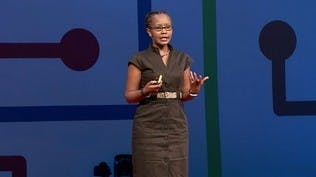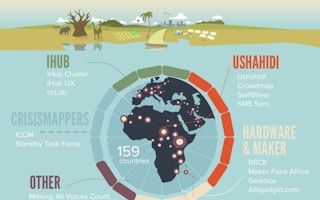Juliana Rotich is the co-founder and Executive Director of Ushahidi, a nonprofit technology company that develops free, open-source software for data gathering and application.
The organisation started out as a website that helped restore public safety during the 2007–2008 Kenyan crisis after a disputed presidential election. Ushahidi has since benefitted many societies in situations ranging from mapping oil spills to managing earthquake recovery.
In this interview with CLC’s Hazelina Yeo, she explains how technology can bring cities and their citizens closer together.
Tell us about Ushahidi in 2030.
First, Ushahidi will keep creating and maintaining open-source software for changing information flow – mobile apps, things like Ping, SMSsync – different tools grounded in being able to work not just in Africa, but anywhere.

Juliana Rotich, co-founder and executive director of Ushahidi.
Second, Ushahidi will be a catalyst playing a very important role in communities, such as promoting open innovation with the iHub in Nairobi, Kenya, and spinning out companies and initiatives like the Crisis Mappers Network and BRCK, the Wi-Fi hotspot router.
Third, Ushahidi will aim to stay influential with expertise, implementation and consulting, with solutions tailored for cities to be more resilient, working with officials in emerging markets to really figure out what it means to have technology as part of the problem-solving kit. We often say technology is 10 per cent of what is needed for impact. The other 90 per cent is typically a lot of partnerships, engagement, commitment, community and expertise around problems such as responding to disasters.
How can cities benefit from Ushahidi?
Cities can use Ushahidi to bring down costs significantly. The tools create information flows in a much more collaborative way of engaging citizens as part of the solution, and also to provide a channel for the city to respond to its citizens. For example, in Dublin, Ireland, the FixMyStreet software was used to report things broken around the city, like potholes. The city committed to responding within 48 hours.
One of Ushahidi’s strengths is that the software is open-source, so people can modify, customise and localise it. One should be able to use it without having to know how to code. Anyone who has used blogging software, like WordPress, can pretty much just work on it. The software is translated to over 40 different languages, which makes it even more impactful.
How are technology and innovation altering urban governance?
Urban governance can be participatory and inclusive when you use tools like Ushahidi, particularly in areas that may otherwise be marginalised. For example, Voice of Kibera is an implementation of Ushahidi in Kibera, one of the largest slums in Africa, giving a collective global voice to the residents while in the process of digitally mapping the area.
Please recommend one Ushahidi product that will be useful to a city like Singapore.
The Ushahidi Data Studio creates a dashboard that serves as a crowdsourcing platform to engage the people on areas such as air quality. It’s an additional tool that can pull in information from Ushahidi and other sources such as Excel spreadsheets, giving municipal decision-makers a clearer picture of the ground.
Urban leaders and planners can create their own dashboard. Ushahidi can work with cities and resilience officers in the 100 Resilient Cities Network to figure out what needs to go into this dashboard. For example, a dashboard of crisis data can be useful for decisionmaking. A dashboard for Singapore would be quite different from that for other cities.
“
Urban governance can be participatory and inclusive when you use tools like Ushahidi, particularly in areas that may otherwise be marginalised.
Name some affordable measures that cities can look into to be more resilient.
Different cities need to be resilient in different ways. In terms of affordable measures, OpenMRS or FrontlineSMS are very useful tools that can be used to manage information in the healthcare space.
More importantly, cities need to look at which communities they can work with to be more resilient, which communities to empower, to provide technology and training for, so that when something happens, those communities that know how to use technology can help respond. Technology is just one part. Strategy, community building and engaging the community are also part of the special “sauce” that makes cities more resilient.
Are there urban sustainability problems that Ushahidi plans to solve in future?
Ushahidi tries to solve problems around information flow, which crosscuts many urban problems around the environment such as air quality, as well as around service, such as service delivery from the city government. Ushahidi can be an enabler of change, to give people tools to gather and contextualise information, and come up with solutions with the larger community.
As a new World Cities Summit Young Leader, what do you hope to bring to the table?
I hope to bring about an appreciation of the opportunities that abound when working with emerging markets and developing countries, and being grounded in the reality of difficult, edge-type environments. These places give different challenges, but also inspire better tools, technology and strategies that can be scalable to other countries.










